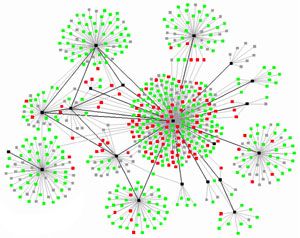 People are doing lots of things in response to job losses in the current economy, so what makes LinkedIn remarkable? Joining this type of network is a trend I expect to continue independent of the job market. Here’s why: Not only does LinkedIn demonstrate the power of social media, it shows the broader reframing of how social media has changed the way people think about accessing information and the world. People have moved from hunting for “jobs” to connecting with people. And for good reason.
People are doing lots of things in response to job losses in the current economy, so what makes LinkedIn remarkable? Joining this type of network is a trend I expect to continue independent of the job market. Here’s why: Not only does LinkedIn demonstrate the power of social media, it shows the broader reframing of how social media has changed the way people think about accessing information and the world. People have moved from hunting for “jobs” to connecting with people. And for good reason.
We know from network theorists, such as Mark Granovetter and his seminal 1973 paper “The Strength of Weak Ties,” and Albert-Laszlo Barabasi, whose user-friendly book, Linked: How Everything Is Connected to Everything Else and What It Means* takes a broader look at the development of network theory, why social media networks like LinkedIn have such tremendous reach and power. Granovetter showed that people were more likely to get jobs from friends of friends, rather than immediate friends. The logic is that we know the same people our friends know and therefore if they knew about a career opportunity, we would probably already know about it, too. But your friend’s friends are more likely to know people you don’t know who know about career opportunities you haven’t heard about.

Some people are especially good at being parts of several different networks. The people who connect the unconnected are called “weak links.” This does not mean the same thing as “The Weakest Link” of television quiz show fame, the weak link in network theory is where you start to get really powerful information flows because weak links connect previously unconnected people. Because LinkedIn allows you to be your own weak link, connecting to people and potential career opportunities beyond your immediate network, it is an extraordinarily effective resource for career change, industry information, and employment opportunities.

You could, of course, just post your resume to Monster.com, visit a number of other job posting sites, send out your resume to everyone in your Outlook file, or go to the local grocery store and read the bulletin board. However, because LinkedIn focuses on people, it not only expands the scope of your search but creates a network with trust created between connector referrals. Someone who is referred by someone you know (or someone who knows someone you know) is much more likely to be a good fit. This creates a connection that is psychologically more comfortable and conducive to a positive interaction. Call it transitive trust. The reciprocity and shared community of online networks builds a sense of camaraderie and trust between members and provides an element of emotional support.
LinkedIn isn’t the only network for professionals, but it has managed to gather critical mass which means you are potentially connected to a vast network of people. Personally, I like that people have figured out how to connect to and help each other. Like the six degrees of separation illustrated in sociologist Stanley Milgram “small world experiment” in 1967, it really does make the world a smaller place. Have you set up your profile yet?
—-
*These should be required reading for anyone working with or interested in social media applications because they explain why the networks work. A 1983 version where Granovetter reviews studies tested and elaborated on his hypothesis “The Strength of Weak Ties: A Network Theory Revisited” is available on the web if you Google it. Or if you’re a commuter, exerciser, or aural learner, you can get a downloadable audio file of Barabasi’s Linked in from Audible.com.
Barabasi, Albert-Laszlo (2003). Linked – How Everything is Connected to Everything Else and What it Means for Business, Science, and Everyday Life. Plume. ISBN 0-452-28439-2.
Granovetter, M. (1973). “The Strength of Weak Ties”, American Journal of Sociology, Vol. 78, Issue 6, May 1973, pp. 1360-1380. Note: Travers, Jeffrey; Stanley Milgram (December 1969). “An Experimental Study of the Small World Problem”. Sociometry 32 (4): 425-443.

 Dr. Pamela Rutledge is available to reporters for comments on the psychological and social impact of media and technology on individuals, society, organizations and brands.
Dr. Pamela Rutledge is available to reporters for comments on the psychological and social impact of media and technology on individuals, society, organizations and brands.